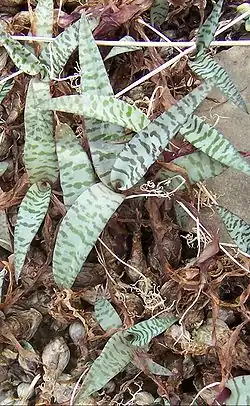Ledebouria socialis
| Ledebouria socialis | |
|---|---|

| |
| Scientific classification | |
| Kingdom: | Plantae |
| Clade: | Tracheophytes |
| Clade: | Angiosperms |
| Clade: | Monocots |
| Order: | Asparagales |
| Family: | Asparagaceae |
| Subfamily: | Scilloideae |
| Genus: | Ledebouria |
| Species: | L. socialis
|
| Binomial name | |
| Ledebouria socialis (Baker) Jessop
| |
| Synonyms | |
Ledebouria socialis, the silver squill, wood hyacinth, or leopard lily, is a geophytic species of bulbous perennial plant native to the Eastern Cape Province of South Africa.[1] It was first described by John Gilbert Baker as Scilla socialis in 1870.[2] John Peter Jessop later revised the genus Scilla and split off several species, reclassifying Scilla socialis into the genus Ledebouria in 1970.[3] It is often cultivated and grows well with minimal care.[4]
Etymology
Ledebouria is named for Carl Friedrich von Ledebour (1785–1851),[5] a botanist who published, among other things, the first complete Russian flora.[6]
Socialis means 'growing in pure stands', 'dominant', or 'growing in colonies'.[5]
References
- ^ "Silver Squill Care: All About Growing Ledebouria Socialis". 14 February 2022.
- ^ "Scilla socialis Baker". Germplasm Resources Information Network. Agricultural Research Service, United States Department of Agriculture. Retrieved 14 March 2010.
- ^ "Ledebouria socialis". International Plant Names Index (IPNI). Royal Botanic Gardens, Kew; Harvard University Herbaria & Libraries; Australian National Botanic Gardens. Retrieved 14 March 2010.
- ^ Zachos, E. 2005. Tempting Tropicals: 175 Irresistible Indoor Plants. Portland, Oregon: Timber Press. pp. 221–222.
- ^ a b Gledhill, David (2008). "The Names of Plants". Cambridge University Press. ISBN 9780521866453 (hardback), ISBN 9780521685535 (paperback). pp 232, 355
- ^ "Flora Rossica". Biodiversity Library. Biodiversity Heritage Library. 1842. Retrieved 4 July 2018.
External links
![]() Media related to Ledebouria socialis at Wikimedia Commons
Media related to Ledebouria socialis at Wikimedia Commons